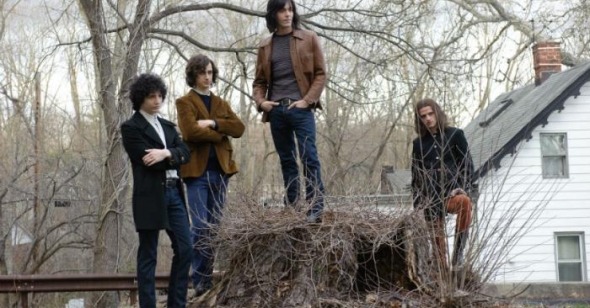B-Side
By Benjamin Mercer
Not Fade Away
Dir. David Chase, U.S., Paramount Vantage
“What kind of movie is this?” the protagonist of Not Fade Away wonders aloud to his girlfriend as they’re taking in Antonioni’s Blow-Up during an evening out. Of course, it’s an altogether easier question to answer in the case of this rather halting Künstlerroman about a musician who’s an amateur in nearly every estimation but his own. The first feature film written and directed by Sopranos creator David Chase, Not Fade Away is principally a period film: a small-scale dramedy set against the backdrop of the tumultuous sixties as they unfold in a tri-state town within spitting distance of—but a world away from—the Village’s bohemian mecca.
From the beginning, Chase cues up a familiar backbeat of current events both cultural and historical—he opens with a one-off dramatization of Keith Richards and Mick Jagger’s storied meeting on a London train; heavy references to the Kennedy assassination follow soon thereafter; and the Vietnam War eventually makes for heated dinner-table conversation. Not long after we’re introduced to the scrawny drummer Douglas (John Magaro), he’s complaining about how girls don’t like him, but in short order he’s home from college for Christmas break, possessed of a newfound swagger. His hard-ass father (James Gandolfini) and put-upon mother (Molly Price) are none too pleased that he’s grown his hair out into a Bob Dylan tangle. Dad refers to his son’s accompanying Cuban heels as “nigger shoes”—perhaps the boldest part of the film is that its dialogue attempts a head-on portrayal of the ugly attitudes inherent in this suburban New Jersey community throughout the transformative decade in question (the word “fag” is also present, in spades). In one of the film’s better scenes, Chase shows the staunchly countercultural Douglas stumbling over his own assumptions based on race: the young man, a hardcore listener of the blues, tries to relate to a black coworker via the music’s lyrics and is stunned when his ditch-digging companion responds by recommending the “soulful” music of Tony Bennett.
The stage here feels crowded—a band-dynamics saga and a love story (the two occasionally intersect) also jockey for the spotlight. Much to his father’s dismay, Douglas drops out of school to focus on his band back home, which includes rock-god wannabe Eugene (Jack Huston) and the more thoughtful Wells (Will Brill). Their unnamed group undergoes a number of lineup changes—with Douglas eventually ousting Eugene as lead singer—and shifts focus away from copycat blues-rock covers toward somewhat janglier original material. Much of the script’s humor derives from their delusions of grandeur: while they remain in their hometown, talking about the band more than refining its sound, they clearly expect the world—major-label deals, sold-out tours, feeding-frenzy press conferences. Amid these assumptions of a bright future, Douglas begins a romance with his high-school crush, Grace (Bella Heathcote). The film’s portrait of cusp-of–Summer of Love coupledom is one of its fresher aspects, although Grace’s home life becomes the film’s most glaring false note. Her older sister, Joy (Dominique McElligott), is introduced as extremely nonconformist, later suggested to be mentally unstable, and then promptly institutionalized by her unfeeling country-club parents.
While most of the touchstones here are musical (from Sgt. Pepper’s on out), Blow-Up is far from the only cinematic reference. Early on, we see a theater marquee advertising Vincent Price in The Pit and the Pendulum; later, Douglas and Grace watch Touch of Evil on television, and Grace reads aloud a text by Orson Welles. The two also attend a showing at a drive-in, where the projected images in the background become a vital component in a scene primarily depicting the couple’s stability during otherwise difficult times. Douglas develops his own ideas about moviemaking, as well. At a family cookout, Douglas defends himself against lightly critical family members by observing, pretentiously, that music and movies are “the only two art forms that take place over elapsed time.” He also, eventually, sets his sights on film school, expressing particular interest in the interplay between music and the film image.
All this moving-image material is meant to have a deflationary effect in some respects—the snippets of pristine finished works like Blow-Up and Touch of Evil further highlight the fact that Douglas (as yet, at least) has no achievements of real substance to back up his posturing—but it also winds up calling further attention to Not Fade Away’s own piecemeal assembly. The film is frequently entertaining to look at and listen to: Magaro convincingly plays disaffection from a spaced-out remove that seems both studied and genuine, and he nails the scenes in which he depicts Douglas’s outraged but rather confused radicalism; musical supervisor Steven Van Zandt (of the E Street Band and The Sopranos) has curated a surprisingly eclectic soundtrack; and there’s a strong overall sense of suburban place. But Not Fade Away is essentially a loose national-through-the-personal rundown of the sixties, and as such its overarching narrative feels distinctly secondhand. In short, it’s something like a greatest-hits record—engineered to please the crowd, but as a whole somehow unsatisfying, lacking the texture of a less overstuffed long-player.
